Ankle Sprains/Instability

Ankle sprains are a common injury. They usually occur when the foot is forcefully inverted or turned inward. Grade I (minor tear), Grade II (partial tear), or a Grade III (complete tear into two pieces) damage of the outer ligament complex (the anterior talofibular ligament and less often the calcaneofibular ligaments) is the result. Injuries to the inner aspect of the ankle are rare and often result in a fracture before ligamentous damage occurs.
Signs and symptoms of an ankle sprain include lateral ankle pain, swelling and a sense of instability. Stress X-rays may be helpful in ruling out fractures.
Treatment of an acute injury requires rest, ice, compression, elevation, and bracing of the injured ankle. Early rehabilitation assists in a rapid recovery. Surgery (reconstruction of the ligaments) is only
necessary when the ankle is repeatedly sprained.
Fractures (Broken Bones)
Fractures may involve the outside or inside of the leg. The signs and symptoms of fractures are pain, swelling and bony deformities. X-rays are essential and rapid “reduction” (setting the bones close together for healing) is necessary. In extreme cases, open surgery is necessary to reduce the fracture. Often pins, plates and screws are used to maintain the reduction.
Plantar Fasciitis
Inflammation of the fascia on the bottom of the foot is the most common cause of heel pain.
There are many documented causes of plantar fasciitis. Poor flexibility of the calf muscles, no arch support, a sudden increase in one’s level of activity, poor footwear, being overweight, excessive
pronation, or repetitive stress conditions (long distance running). Common causes of a bruised heel bone are poor cushioning of the heel due to fat pad atrophy (shrinkage in the size of the fat pad) poor footwear, excessive walking on hard surfaces, and being overweight.
Depending on which medical study you read, anywhere form 8-21% of the population suffers from plantar fasciitis. The pain is typically located at the front of the base of the calcaneus. Less often, the pain
extends along the arch of the foot. The result is micro-tearing of the plantar fascia where it attaches to the base of the calcaneus. An ensuing inflammatory response occurs producing pain, swelling, warmth,
loss of function (difficulty with any standing or walking), and less often, redness.
Plantar fasciitis is often worst in the morning when one takes his /her first steps out of bed. Theories propose that when we are sleeping, the inflamed fascia is shortening and perhaps attempting to
heal. If the problem is chronic, a bone spur may be seen on x-ray.
Currently, we believe that a bone spur is not the cause of the pain but the result of the body’s attempt to heal the damaged plantar fascia.
